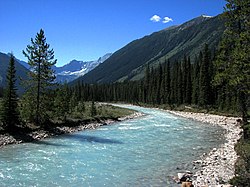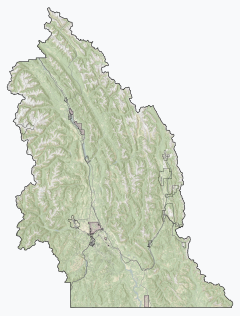East Kootenay | |
|---|---|
| Regional District of East Kootenay | |
 | |
Major communities | |
 Location in British Columbia | |
| Coordinates: 49°55′00″N 115°45′00″W / 49.9167°N 115.75°W | |
| Country | Canada |
| Province | British Columbia |
| Administrative office location | Cranbrook |
| Government | |
| • Type | Regional district |
| • Body | Board of directors |
| • Chair | Rob Gay (C) |
| • Vice chair | Susan Clovechok (F) |
| • Electoral areas | A, B, C, E, F, G |
| Area | |
| • Land | 27,541.84 km2 (10,633.96 sq mi) |
| Population (2021)[2] | |
| • Total | 65,896 |
| • Density | 2.4/km2 (6/sq mi) |
| Time zones | |
| Most of the district | UTC-7 (Mountain (MST)) |
| • Summer (DST) | UTC-6 (Mountain Daylight (MDT)) |
| Electoral area C (no DST) | UTC-7 (Mountain (MST)) |
| Website | www |
The Regional District of East Kootenay (RDEK) is a regional district in the Canadian province of British Columbia, Canada. In the 2016 census, the population was 60,439. Its area is 27,542.69 km2 (10,634.29 sq mi). The regional district offices are in Cranbrook, the largest community in the region. Other important population centres include the cities of Kimberley and Fernie, and the district municipality of Invermere and Sparwood. Despite its name, the regional district does not include all of the region known as the East Kootenay, which includes the Creston Valley and the east shore of Kootenay Lake.
Geography
[edit]The regional district's dominant landform is the Rocky Mountain Trench, which is flanked by the Purcell Mountains and Rocky Mountains on the east and west, and includes the Columbia Valley region, the southern half of which is in the regional district (its northern half is in the Columbia-Shuswap Regional District). Another distinct area within the regional district is the Elk Valley in the southern Rockies, which is the entrance to the Crowsnest Pass and an important coal-mining region. Other than the Columbia and Kootenay Rivers, whose valleys form the bottomlands of the Rocky Mountain Trench, also included in the regional district are the northernmost parts of the basins of the Flathead, Moyie and Yahk Rivers (the Moyie and Yahk are tributaries of the Kootenay, entering it in the United States, and the Flathead is a tributary of the Clark Fork in Montana).
Demographics
[edit]As a census division in the 2021 Census of Population conducted by Statistics Canada, the Regional District of East Kootenay had a population of 65,896 living in 28,264 of its 35,931 total private dwellings, a change of 9% from its 2016 population of 60,439. With a land area of 27,514.1 km2 (10,623.3 sq mi), it had a population density of 2.4/km2 (6.2/sq mi) in 2021.[3]
| Panethnic group |
2021[4] | 2016[5] | 2011[6] | 2006[7] | 2001[8] | 1996[9] | ||||||
|---|---|---|---|---|---|---|---|---|---|---|---|---|
| Pop. | % | Pop. | % | Pop. | % | Pop. | % | Pop. | % | Pop. | % | |
| European[a] | 55,750 | 86.54% | 52,340 | 88.36% | 50,385 | 90.5% | 50,520 | 92.05% | 51,740 | 92.57% | 52,560 | 93.9% |
| Indigenous | 5,495 | 8.53% | 4,705 | 7.94% | 3,780 | 6.79% | 3,425 | 6.24% | 2,890 | 5.17% | 2,110 | 3.77% |
| Southeast Asian[b] | 840 | 1.3% | 550 | 0.93% | 285 | 0.51% | 130 | 0.24% | 275 | 0.49% | 155 | 0.28% |
| South Asian | 825 | 1.28% | 355 | 0.6% | 250 | 0.45% | 150 | 0.27% | 300 | 0.54% | 350 | 0.63% |
| East Asian[c] | 780 | 1.21% | 670 | 1.13% | 545 | 0.98% | 485 | 0.88% | 420 | 0.75% | 505 | 0.9% |
| African | 395 | 0.61% | 305 | 0.51% | 165 | 0.3% | 50 | 0.09% | 155 | 0.28% | 115 | 0.21% |
| Latin American | 190 | 0.29% | 145 | 0.24% | 90 | 0.16% | 15 | 0.03% | 70 | 0.13% | 50 | 0.09% |
| Middle Eastern[d] | 25 | 0.04% | 60 | 0.1% | 0 | 0% | 70 | 0.13% | 0 | 0% | 10 | 0.02% |
| Other[e] | 100 | 0.16% | 110 | 0.19% | 145 | 0.26% | 30 | 0.05% | 40 | 0.07% | 125 | 0.22% |
| Total responses | 64,420 | 97.76% | 59,235 | 98.01% | 55,675 | 98.22% | 54,885 | 98.92% | 55,890 | 99.29% | 55,975 | 99.31% |
| Total population | 65,896 | 100% | 60,439 | 100% | 56,685 | 100% | 55,485 | 100% | 56,291 | 100% | 56,366 | 100% |
- Note: Totals greater than 100% due to multiple origin responses.
Municipalities
[edit]| Municipality | Government Type | Population |
|---|---|---|
| Cranbrook | city | 20,047 |
| Kimberley | city | 8,115 |
| Fernie | city | 5,249 |
| Sparwood | district municipality | 3,784 |
| Invermere | district municipality | 3.391 |
| Jumbo Glacier | mountain resort municipality | 0 |
| Elkford | district municipality | 2,499 |
| Radium Hot Springs | village | 776 |
| Canal Flats | village | 668 |
Health care
[edit]The largest hospital in the region is the East Kootenay Regional Hospital in Cranbrook.[10] There are also hospitals in Creston (Creston Valley Hospital),[11] Fernie (Elk Valley Hospital),[12] Invermere (Invermere & District Hospital),[13] and Golden (Golden & District Hospital).[14] Primary health centers are present in Sparwood and Elkford.[15][16]
First Nations
[edit]The First Nations people who live in the East Kootenay are from the Ktunaxa Nation.[17] There are currently four bands Columbia Lake First Nation near Windermere, Lower Kootenay First Nation near Creston, St. Mary's First Nation near Cranbrook, and Tobacco Plains First Nation near Grasmere.[17]
See also
[edit]Notes
[edit]- ^ Statistic includes all persons that did not make up part of a visible minority or an indigenous identity.
- ^ Statistic includes total responses of "Filipino" and "Southeast Asian" under visible minority section on census.
- ^ Statistic includes total responses of "Chinese", "Korean", and "Japanese" under visible minority section on census.
- ^ Statistic includes total responses of "West Asian" and "Arab" under visible minority section on census.
- ^ Statistic includes total responses of "Visible minority, n.i.e." and "Multiple visible minorities" under visible minority section on census.
References
[edit]- ^ "Board of Directors". Retrieved July 9, 2019.
- ^ a b "Population and dwelling counts, for Canada, provinces and territories, and census divisions, 2016 and 2011 censuses – 100% data (British Columbia)". Statistics Canada. February 8, 2017. Retrieved July 9, 2019.
- ^ "Population and dwelling counts: Canada and census divisions". Statistics Canada. February 9, 2022. Retrieved April 3, 2022.
- ^ Government of Canada, Statistics Canada (October 26, 2022). "Census Profile, 2021 Census of Population". www12.statcan.gc.ca. Retrieved February 21, 2023.
- ^ Government of Canada, Statistics Canada (October 27, 2021). "Census Profile, 2016 Census". www12.statcan.gc.ca. Retrieved February 21, 2023.
- ^ Government of Canada, Statistics Canada (November 27, 2015). "NHS Profile". www12.statcan.gc.ca. Retrieved February 21, 2023.
- ^ Government of Canada, Statistics Canada (August 20, 2019). "2006 Community Profiles". www12.statcan.gc.ca. Retrieved February 21, 2023.
- ^ Government of Canada, Statistics Canada (July 2, 2019). "2001 Community Profiles". www12.statcan.gc.ca. Retrieved February 21, 2023.
- ^ Government of Canada, Statistics Canada (June 4, 2019). "Electronic Area Profiles Profile of Census Divisions and Subdivisions, 1996 Census". www12.statcan.gc.ca. Retrieved February 21, 2023.
- ^ "Information Page". www.interiorhealth.ca. Retrieved January 4, 2021.
- ^ "Information Page". www.interiorhealth.ca. Retrieved January 4, 2021.
- ^ "Information Page". www.interiorhealth.ca. Retrieved January 4, 2021.
- ^ "Invermere & District Hospital". www.interiorhealth.ca. Retrieved January 4, 2021.
- ^ "Golden & District Hospital". www.interiorhealth.ca. Retrieved January 4, 2021.
- ^ "Sparwood Primary Health Care". www.interiorhealth.ca. Retrieved January 4, 2021.
- ^ "Elkford Health Centre". www.interiorhealth.ca. Retrieved January 4, 2021.
- ^ a b "Our History – Lower Kootenay Band". lowerkootenay.com. Retrieved January 4, 2021.
- [1] Census Profile, 2016 Census, East Kootenay
External links
[edit]- Official website

 East Kootenays travel guide from Wikivoyage
East Kootenays travel guide from Wikivoyage

